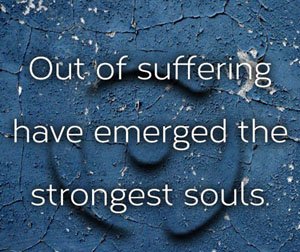Safety is Universal (T.I.C. 1)
“After all, when a stone is dropped into a pond, the water continues quivering even after the stone has sunk to the bottom.”
– Arthur Golden, Memoirs of a Geisha
We keep hearing more about trauma and post-traumatic stress disorder, and speaking as a trauma counselor, that’s a great thing. Recovery from school shootings, natural disasters and terrorist attacks have made healing from trauma a more common topic in the news. Shows like The Walking Dead, many CSI dramas have touched on traumatic stress directly or indirectly. Over the last seventy years we’ve moved to attempting to understand PTSD as a spinal disorder (some of the earliest accounts), through a degree of denial and minimization, to a point of acceptance where the Netflix blockbuster, Marvel Comic’s Jessica Jones has a hero who lives with PTSD as the title star.
Hospitals and counselors across the nation have made great strides in becoming “Trauma Informed” caregivers; essentially noting that trauma, and its effects on a person, are more common than originally expected and that we can help ease these symptoms while helping client repair what is essentially a memory processing problem.
This involves “‘connecting the dots’ for trauma survivors” According to Licensed Clinical Social Worker Lisa Ferentz (2016). Counselors and programs help survivors “understand the long-term emotional, physical, behavioral, and psychological impact of trauma, and the ways in which traumatic experiences are processed and stored in the brain. They also focus on the inevitable coping strategies that emerge for survival and are able to de-pathologize those ‘symptoms.’”
Informed and United
“Just as the body goes into shock after a physical trauma, so does the human psyche go into shock after the impact of a major loss.”
– Anne Grant, Author
 Any counselor or member of a trauma informed program should stand proud as an ally in the fight against this totally treatable disorder. One of the greatest champions in the fight is the Substance Abuse and Mental Health Services Administration (SAMHSA) with their manual TIP 57: Trauma-Informed Care in Behavioral Health Services. TIP 57 “discusses patient assessment, treatment planning strategies that support recovery, and building a trauma-informed care workforce” (SAMHSA, 2014).The TIP 57 is notes a number of key components which are tenants of trauma-informed care, help bring the cerebral and neurological aspects of this disorder down to earth, and make them approachable and understandable to us all.
Any counselor or member of a trauma informed program should stand proud as an ally in the fight against this totally treatable disorder. One of the greatest champions in the fight is the Substance Abuse and Mental Health Services Administration (SAMHSA) with their manual TIP 57: Trauma-Informed Care in Behavioral Health Services. TIP 57 “discusses patient assessment, treatment planning strategies that support recovery, and building a trauma-informed care workforce” (SAMHSA, 2014).The TIP 57 is notes a number of key components which are tenants of trauma-informed care, help bring the cerebral and neurological aspects of this disorder down to earth, and make them approachable and understandable to us all.
As we look at each aspect in an intermittent KeithKarabin.com series, one picture will hopefully become clear. Not only are these keys crucial to overcoming PTSD, they are also based in needs that we all have or comforts which we all benefit from. Trauma exposure is common in the United States, according to SAMHSA (2014), and the methods to heal are not based in how we differ, but in how we are the same.
We All Seek Safety
“Someone who has experienced trauma also has gifts to offer all of us – in their depth, their knowledge of our universal vulnerability, and their experience of the power of compassion.”
– Sharon Salzberg, Buddhist Author
As with all of us, any healing begins with Safety. That’s an intentional capitol “S.” We all need to feel safe and secure to be healthy. In trauma informed care that need is magnified. We’ve broken SAMHSA’s recommendation into three simple categories:
Safe from our Symptoms
For all of us, difficult or unsettled memories can bring strong feelings or thoughts that we cope with in unhelpful ways. We can also be more fearful, untrusting or worried all the time. A trauma-safe program, counselor or treatment center, helps us feel able to care for ourselves, connected to our supporters and stronger over time.
In practice, as employed by Ferentz, this “means incorporating good boundaries and making sure that the material that surfaces in session is sufficiently contained so clients can leave the office and function well in the outside world” (2016).
Safe in our Space
PTSD can cause the fight-or-flight mechanism to either be constantly on or be hyper-reactive. It is like having an alarm bell that only you hear blaring all the time. So, it’s hard to concentrate, focus, and simply be present in our environment some times. “This means moving beyond 50 minutes of ‘talk therapy’ with  clients frozen on the sofa. Instead, clients are encouraged to have a greater awareness of body sensations, and are supported in incorporating movement as trauma narratives are disclosed,” (Ferentz, 2016). As someone who’s helped clients complete many such narratives, which help a person integrated and settle their hard memories, I can also attest that the “frozen on the sofa” effect happens. But a walk in the woods, some shots on the basketball court or throwing paint around can loosen up a heart tightly clenched in self-protection.
clients frozen on the sofa. Instead, clients are encouraged to have a greater awareness of body sensations, and are supported in incorporating movement as trauma narratives are disclosed,” (Ferentz, 2016). As someone who’s helped clients complete many such narratives, which help a person integrated and settle their hard memories, I can also attest that the “frozen on the sofa” effect happens. But a walk in the woods, some shots on the basketball court or throwing paint around can loosen up a heart tightly clenched in self-protection.
But, even more simply, a trauma-safe environment keeps noises, light, smells, uncomfortable places, casual touches or conflict between people to a minimum because they can bring back hard memories. It ensures that a clear schedule is present, and care outlined because we all feel more in control when we know what’s coming.
Safe to Get Better Together
Healing from PTSD is not a solo endeavor. We all need a time to practice safe ways to cope with helpers that we respect. A Trauma-safe team makes the client the key member and works hard to get to know each other. We make sure that we can replace our unhelpful behaviors with helpful ones that fit our style while not hurting ourselves or anyone else along the way.
“For survivors who are seeking therapy that is truly ‘trauma informed,’” Ferentz (2016) encouraged “you to take the time to interview prospective clinicians. Ask about their treatment paradigms and listen for strategies that are expressive and creative, not just cognitive. Ask them about the techniques they use to enhance a sense of safety throughout the therapy process. And listen to your own good instincts about whether or not there is the potential for a therapeutic relationship that will feel genuinely compassionate, non-judgmental, and healing for you.”
While her advice is geared toward therapy seekers, there is wisdom in it for everyone. Perhaps you just went through something or you know someone who has struggled for years—remember, SAMHSA data and modern media agree it’s common!—so let’s all absorb that, though the need may be magnified in PTSD, we all need safety, a calm environment, people we can trust, genuine compassion and non-judgmental relationships. What promotes health in PTSD promotes health in us all.
__________________________________________________
Ferentz, L. (2016) Healing Trauma’s Wounds: The Scoop on “Genuine” Trauma Informed Care. Psychology Today. Retrieved from: https://www.psychologytoday.com/blog/healing-trauma-s-wounds/201603/the-scoop-genuine-trauma-informed-care
SAMHSA (2014) TIP 57: Trauma-Informed Care in Behavioral Health Services. Pages 112-115 and the Trauma-Informed Care Quick Guide pages 11-14 and 18. Retrieved from: http://store.samhsa.gov/product/TIP-57-Trauma-Informed-Care-in-Behavioral-Health-Services/SMA14-4816 *FREE DOWNLOAD


